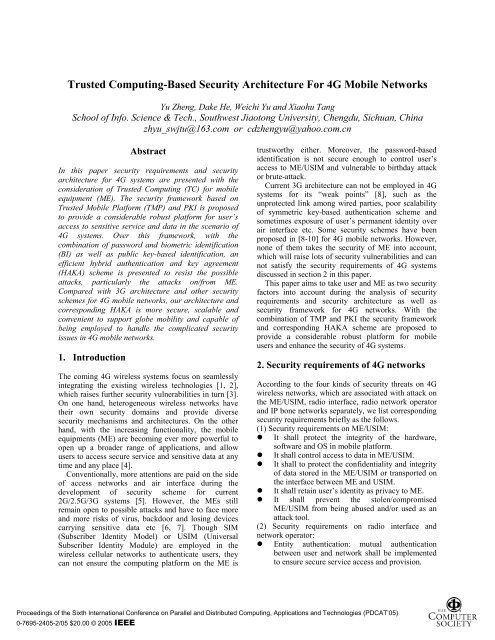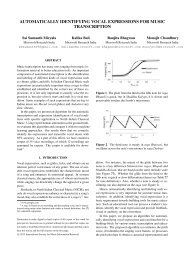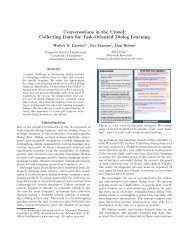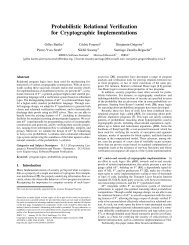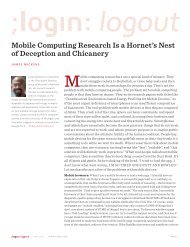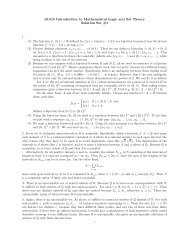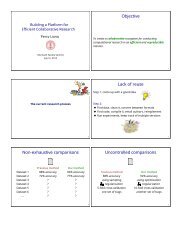Trusted Computing-Based Security Architecture For 4G Mobile ...
Trusted Computing-Based Security Architecture For 4G Mobile ...
Trusted Computing-Based Security Architecture For 4G Mobile ...
Create successful ePaper yourself
Turn your PDF publications into a flip-book with our unique Google optimized e-Paper software.
<strong>Trusted</strong> <strong>Computing</strong>-<strong>Based</strong> <strong>Security</strong> <strong>Architecture</strong> <strong>For</strong> <strong>4G</strong> <strong>Mobile</strong> Networks<br />
Yu Zheng, Dake He, Weichi Yu and Xiaohu Tang<br />
School of Info. Science & Tech., Southwest Jiaotong University, Chengdu, Sichuan, China<br />
zhyu_swjtu@163.com or cdzhengyu@yahoo.com.cn<br />
Abstract<br />
In this paper security requirements and security<br />
architecture for <strong>4G</strong> systems are presented with the<br />
consideration of <strong>Trusted</strong> <strong>Computing</strong> (TC) for mobile<br />
equipment (ME). The security framework based on<br />
<strong>Trusted</strong> <strong>Mobile</strong> Platform (TMP) and PKI is proposed<br />
to provide a considerable robust platform for user’s<br />
access to sensitive service and data in the scenario of<br />
<strong>4G</strong> systems. Over this framework, with the<br />
combination of password and biometric identification<br />
(BI) as well as public key-based identification, an<br />
efficient hybrid authentication and key agreement<br />
(HAKA) scheme is presented to resist the possible<br />
attacks, particularly the attacks on/from ME.<br />
Compared with 3G architecture and other security<br />
schemes for <strong>4G</strong> mobile networks, our architecture and<br />
corresponding HAKA is more secure, scalable and<br />
convenient to support globe mobility and capable of<br />
being employed to handle the complicated security<br />
issues in <strong>4G</strong> mobile networks.<br />
1. Introduction<br />
The coming <strong>4G</strong> wireless systems focus on seamlessly<br />
integrating the existing wireless technologies [1, 2],<br />
which raises further security vulnerabilities in turn [3].<br />
On one hand, heterogeneous wireless networks have<br />
their own security domains and provide diverse<br />
security mechanisms and architectures. On the other<br />
hand, with the increasing functionality, the mobile<br />
equipments (ME) are becoming ever more powerful to<br />
open up a broader range of applications, and allow<br />
users to access secure service and sensitive data at any<br />
time and any place [4].<br />
Conventionally, more attentions are paid on the side<br />
of access networks and air interface during the<br />
development of security scheme for current<br />
2G/2.5G/3G systems [5]. However, the MEs still<br />
remain open to possible attacks and have to face more<br />
and more risks of virus, backdoor and losing devices<br />
carrying sensitive data etc [6, 7]. Though SIM<br />
(Subscriber Identity Model) or USIM (Universal<br />
Subscriber Identity Module) are employed in the<br />
wireless cellular networks to authenticate users, they<br />
can not ensure the computing platform on the ME is<br />
trustworthy either. Moreover, the password-based<br />
identification is not secure enough to control user’s<br />
access to ME/USIM and vulnerable to birthday attack<br />
or brute-attack.<br />
Current 3G architecture can not be employed in <strong>4G</strong><br />
systems for its “weak points” [8], such as the<br />
unprotected link among wired parties, poor scalability<br />
of symmetric key-based authentication scheme and<br />
sometimes exposure of user’s permanent identity over<br />
air interface etc. Some security schemes have been<br />
proposed in [8-10] for <strong>4G</strong> mobile networks. However,<br />
none of them takes the security of ME into account,<br />
which will raise lots of security vulnerabilities and can<br />
not satisfy the security requirements of <strong>4G</strong> systems<br />
discussed in section 2 in this paper.<br />
This paper aims to take user and ME as two security<br />
factors into account during the analysis of security<br />
requirements and security architecture as well as<br />
security framework for <strong>4G</strong> networks. With the<br />
combination of TMP and PKI the security framework<br />
and corresponding HAKA scheme are proposed to<br />
provide a considerable robust platform for mobile<br />
users and enhance the security of <strong>4G</strong> systems.<br />
2. <strong>Security</strong> requirements of <strong>4G</strong> networks<br />
According to the four kinds of security threats on <strong>4G</strong><br />
wireless networks, which are associated with attack on<br />
the ME/USIM, radio interface, radio network operator<br />
and IP bone networks separately, we list corresponding<br />
security requirements briefly as the follows.<br />
(1) <strong>Security</strong> requirements on ME/USIM:<br />
It shall protect the integrity of the hardware,<br />
software and OS in mobile platform.<br />
<br />
<br />
It shall control access to data in ME/USIM.<br />
It shall to protect the confidentiality and integrity<br />
of data stored in the ME/USIM or transported on<br />
the interface between ME and USIM.<br />
It shall retain user’s identity as privacy to ME.<br />
It shall prevent the stolen/compromised<br />
ME/USIM from being abused and/or used as an<br />
attack tool.<br />
(2) <strong>Security</strong> requirements on radio interface and<br />
network operator:<br />
Entity authentication: mutual authentication<br />
between user and network shall be implemented<br />
to ensure secure service access and provision.<br />
Proceedings of the Sixth International Conference on Parallel and Distributed <strong>Computing</strong>, Applications and Technologies (PDCAT’05)<br />
0-7695-2405-2/05 $20.00 © 2005 IEEE
Ensure confidentiality of data including user<br />
traffic and signaling data on wired or wireless<br />
interface.<br />
Ensure integrity and origin authentication of user<br />
traffic, signaling data and control data.<br />
<strong>Security</strong> of user identity: It shall protect user<br />
identity confidentiality, user location<br />
confidentiality and user untraceability.<br />
Lawful interception: It shall be possible for law<br />
enforcement agencies to monitor and intercept<br />
every call in accordance with national laws.<br />
(3) <strong>Security</strong> visibility, configurability and scalability:<br />
The security features of the visited network<br />
should be transparent to user.<br />
The user can negotiate acceptable security lever<br />
with the visited network when user roams outside<br />
HE (home environment).<br />
The security mechanism shall be scalable to<br />
support increase of user and/or network elements.<br />
3. Overview Of <strong>Trusted</strong> <strong>Mobile</strong> Platform<br />
In 2004, <strong>Trusted</strong> <strong>Computing</strong> Group (TCG) [11]<br />
develops TMP hardware architecture, software<br />
architecture and protocol specifications [12-14], which<br />
defines comprehensive end-to-end security architecture<br />
and focuses on mobile platform identity and integrity<br />
to prove trusted computing (TC) for ME. The generic<br />
two processors hardware architecture for TMP is<br />
depicted in Fig.1. The darkened components make up<br />
the trust boundary including 1) the application<br />
processor 2) <strong>Trusted</strong> Platform Module (TPM) 3) USIM<br />
4) Core Root of Trust for Measurement (CRTM) 5)<br />
internal flash, 6) memory controllers and 7) DMA<br />
controller. Where CRTM is stored in the ROM memory<br />
and performs the initial trust measurements for the<br />
remainder of platform on power up. While, TPM [15]<br />
is a very important tamper-resistant component in TMP<br />
who is responsible for recording the integrity<br />
measurements of TMP and works closely with the<br />
CRTM to perform trusted boot. TPM also provides<br />
security functionality, such as platform attestation,<br />
protected storage, and sealing, to measure and validate<br />
the hardware and/or software configurations of the<br />
platform. <strong>For</strong> more detail about TMP, refer to [12-15].<br />
Some key features of TMP are listed as the follows,<br />
which are beneficial to enhance the security of ME and<br />
<strong>4G</strong> networks. Firstly, integrity measurement can<br />
provide trusted boot of ME and detect virus or<br />
attacker’s malicious tamper on operating system and/or<br />
application software when ME powers on. Secondly,<br />
RF<br />
Interface<br />
Comm.<br />
Processor<br />
Comm.<br />
Memory<br />
USIM<br />
BUI<br />
Internal<br />
RAM<br />
Memory<br />
Controllor<br />
CRTM<br />
TPM<br />
Internal<br />
Flash<br />
Application<br />
Processor<br />
DMA<br />
Peripheral<br />
External<br />
Memory<br />
Keypad<br />
LCD<br />
BR<br />
USB<br />
SD Card<br />
access networks (AN) can verify the validity of current<br />
state of mobile platform via TMP’s remote attestation<br />
before negotiates sensitive information with ME.<br />
Thirdly, process separation supported by hardware can<br />
resist unauthorized access to the sensitive data from<br />
process in ME, during ME’s operation. Finally,<br />
protected storage can be utilized to safeguard TPM’s<br />
private key and other sensitive information such as<br />
password and biometric template.<br />
Three trusted levels (class 1, 2 and 3) are defined<br />
for TMP in [13]. It is strongly recommended that<br />
password should be used in combination with BI to<br />
authenticate user in security class 3. A TC-based<br />
biometric authentication system is proposed in [16]<br />
and introduced by [13] as a solution example to<br />
identify user. However, the solution is only an offline<br />
local authentication scheme on the premise of that<br />
TPM and user belong to the same certificate authority<br />
(CA). Moreover, the heavy computing loads for<br />
signature in this solution would also increase<br />
transaction time and hinder its enforcement in ME.<br />
What’s more, the BI was not associated with password,<br />
which can not satisfy the security requirements of TMP<br />
class 3.<br />
4. <strong>4G</strong> <strong>Security</strong> <strong>Architecture</strong> & Framework<br />
4.1 Scenario of <strong>4G</strong> security architecture<br />
As shown in fig.2, in terms of the security<br />
requirements the scenario of security architecture for<br />
<strong>4G</strong> wireless networks including the following four<br />
security features (A, B, C, D) on different stratum is<br />
proposed as follows.<br />
A: Network access security: the set of security features<br />
that provide users with secure access to <strong>4G</strong> services<br />
and against attacks on the (radio) access link.<br />
B: Network area security: the set of security features<br />
that enable nodes in the provider domain to securely<br />
exchange data, and protect against attacks on the<br />
wired network and network entities.<br />
C: User area security: the set of security features that<br />
enable secure access to ME/USIM and provide<br />
security environment in ME/USIM.<br />
D: Application security: the set of security features that<br />
enable applications in the user and in the provider<br />
domain to securely exchange messages.<br />
4.2 Theory of public key broadcast protocol<br />
Generally, in order to achieve mutual authentication in<br />
public key-based authentication scheme,<br />
communication participants should verify the validity<br />
of other side’s public-key certificate before their<br />
negotiation. However, it is very difficult for ME to<br />
verify the validity of base station (BS)’s public-key<br />
User Application<br />
C<br />
User USIM<br />
C A A C B<br />
ME/TPM<br />
A<br />
D<br />
Application<br />
Provider Application Stratum<br />
AN<br />
SP<br />
A<br />
B<br />
HE<br />
Serving<br />
Stratum<br />
Transport<br />
Stratum<br />
Figure 1. Generic hardware architecture for trusted mobile platform<br />
Figure 2. Scenario of security architecture for <strong>4G</strong> systems<br />
Proceedings of the Sixth International Conference on Parallel and Distributed <strong>Computing</strong>, Applications and Technologies (PDCAT’05)<br />
0-7695-2405-2/05 $20.00 © 2005 IEEE
certificate since ME and BS usually belongs to<br />
different CA. Thus ME is vulnerable to be cheated by<br />
fake/forged BS. In the scenario of <strong>4G</strong> systems, we<br />
present PKBP as follows to reduce complexity for<br />
certificates validation in ME and resist attack launched<br />
by fake/forged BS.<br />
Every BS co-broadcasts its own public key (PK B ),<br />
identity (ID B ), modulus (N B ) and IPv6 address (IP B )<br />
and those parameters of its neighbors via public<br />
broadcasting channel. E.g., as shown in Fig.3, BS2<br />
broadcasts its public parameters (PK B2 , ID B2 , N B2 , IP B2 )<br />
together with BS1’s (PK B1 , ID B1 , N B1 , IP B1 ) and BS3’s<br />
(PK B3 , ID B3 , N B3 , IP B3 ) separately. Just like BS2, BS1<br />
broadcasts its own parameters and that of BS2 and BS3,<br />
and so on. Thus, a seamless coverage will be formed<br />
on the premise of <strong>4G</strong> network’s seamless coverage. In<br />
fact, the number of fake/forged BS established by<br />
attacker is much smaller than genuine BS in <strong>4G</strong><br />
networks in view of the expensive cost for BS. I.e.<br />
even if attacker publishes its parameters via<br />
fake/forged BS, the number of parameters broadcasted<br />
by genuine BSs is greater than that issued by<br />
forged/fake one.<br />
As shown in Fig.4, a small FIFO (First In First Out)<br />
buffer should be hold in ME, the main role of which is<br />
to store received public-key parameters and<br />
corresponding signal power (SP). As a result, the<br />
number of (PK B1 , ID B1 , N B1 , IP B1 ) in the FIFO is much<br />
more than (PK B ’, ID B ’, N B ’, IP B ’) issued by forged BS.<br />
Then according to SP B1 , which is greater than SP B2 and<br />
SP B3 , MS will access BS1 despite of the most powerful<br />
signal SP B ’. In this way, according to the number of<br />
received public-key parameters and corresponding<br />
signal power, ME can resist attack launched by<br />
fake/forged BS.<br />
4.3 <strong>Security</strong> framework based on TMP & PKI<br />
As shown in Fig.5, according to TMP specifications,<br />
a trusted ME (TME) that comprises of a trusted<br />
biometric reader (BR) and TPM etc. to support TMP<br />
security class 3 is introduced to our security framework.<br />
Where TPM as the heart of TME is banded with and<br />
fixed in the motherland. On the other side, AN, HE,<br />
service provider (SP) and TME manufacturer (MF)<br />
hold a public-key certificate issued by their own<br />
trusted authority respectively which should be<br />
connected via PKI in the scenario of <strong>4G</strong> networks.<br />
The following notations will be used in the<br />
description of our scheme: ID X , SK X , PK X , Cert X and<br />
Sig X denote entity X’s identity, private key, public key,<br />
digital certificate and digital signature separately. H(x)<br />
is a secure hash function and E(k, x) represents<br />
encrypting content x with key k.<br />
sub-net1<br />
BS1<br />
forged<br />
BS<br />
CA1<br />
ME<br />
CA2<br />
BS3<br />
sub-net3<br />
genuine BS<br />
User remembers his password (PW) and holds a<br />
USIM card that is capable of checking the integrity and<br />
validity of the mobile platform and stores some<br />
authenticating parameters including user’s biometric<br />
template (F U , usually is user’s fingerprint), SK User ,<br />
Cert User , Cert HE , x, y and z. The x, y and z are computed<br />
by user’s HE as the follows before HE issues the<br />
USIM card to the user. Where n is a secure module of<br />
RSA signature algorithm.<br />
x=H(F U ||PW),<br />
y=x ⊕ H(PW),<br />
z=S ⊕ H(F U ⊕ PW),<br />
SK<br />
S = H( ID || || ) HE<br />
User<br />
PW FU<br />
modn.<br />
TPM stores SK TPM , symmetric key (K BT ) shared<br />
between BR, Cert TPM as well as integrity metrics of<br />
other components in the TMP. Meanwhile, HE saves<br />
user’s (ID User , S, Cert User ) securely in its database.<br />
In order to access <strong>4G</strong> networks securely, firstly, user<br />
must insert his USIM card into ME and check the<br />
validity of TMP with the help of USIM and AN. If the<br />
state of TMP is reported trustworthy via trusted model<br />
indicator (TMI), user inputs his password and puts his<br />
finger on the BR, and will be identified by TME and<br />
USIM. Finally, authentication between user and AN<br />
will be enforced with the help of USIM and TPM.<br />
4.4 TMP-<strong>Based</strong> Hybrid AKA Scheme<br />
According to <strong>4G</strong> “all-IP” vision, we perceive<br />
authentication as a service performed at the higher<br />
protocol layers irrespective of the underlying network<br />
technology. Two phases of our HAKA by means of<br />
user’s permanent identity (ID User ) are depicted as<br />
follows. (1) In phase 1 local mutual authentication<br />
among user/USIM/TPM will be achieved and preauthentication<br />
between user and AN will be enforced.<br />
(2) In phase 2 remote mutual identification among<br />
user/AN/HE will be implemented as well as key<br />
agreement between AN and user.<br />
4.4.1 Authentication among User/USIM/TPM<br />
M1. USIMTPM: r 1 , ID USIM , D 1 .<br />
M2. TPMBR: r 2 , ID TPM , D 2 .<br />
M3. BRTPM: MAC BR .<br />
MAC BR =E(K BT , r 2 ||ID TPM ||D 3 ). (1)<br />
M4. TPMUSIM: r 3 , Cert TPM , Sig TPM .<br />
Sig TPM =E[SK TPM , r 1 ||r 3 ||ID USIM ||D 4 ]. (2)<br />
M5. USIMAN: r 1 , r 3 , C 1 , Sig TPM , Sig User , Cert TPM .<br />
C 1 =E(PK AN , ID User ||IDC User ||r 4 ||TS), (3)<br />
Sig User =E(SK User , IDC User ||ID TPM ||r 1 ||r 3 ||TS).(4)<br />
M6. ANUSIM: D 5 , MAC AN .<br />
MAC AN =E(r 4 , r 3 ||ID User ||ID TPM ||D 5 ). (5)<br />
M7. USIMTPM: C 2 , C 3 . BRTPM: C 4 .<br />
C 2 =E(PK TPM , r 5 ||y||ID USIM ), (6)<br />
PK B1<br />
ID B1<br />
N B1<br />
IP B1<br />
SP B1<br />
PK B2<br />
ID B2<br />
N B2<br />
IP B2<br />
SP B2<br />
FIFO Buffer<br />
PK B1<br />
ID B1<br />
N B1<br />
IP B1<br />
SP B1<br />
PK B3<br />
ID B3<br />
N B3<br />
IP B3<br />
SP B3<br />
PK B '<br />
ID B '<br />
N B '<br />
IP B '<br />
SP B '<br />
PK B1<br />
ID B1<br />
N B1<br />
IP B1<br />
SP B1<br />
BS2<br />
sub-net2 forged/fake BS<br />
Figure 4. Assert valid BS in FIFO on ME<br />
Figure 3. An example of PKBP over PKI<br />
Proceedings of the Sixth International Conference on Parallel and Distributed <strong>Computing</strong>, Applications and Technologies (PDCAT’05)<br />
0-7695-2405-2/05 $20.00 © 2005 IEEE
Result<br />
User<br />
F U '<br />
TMI<br />
PW<br />
BR<br />
TPM<br />
TME<br />
USIM<br />
Figure 5. <strong>Security</strong> framework based on TMP and PKI<br />
K ST =H[(r 5 ⊕ r 3 )||x||ID TPM ], (7)<br />
C 3 =E(K ST , r 5 ||ID TPM ||F U ||CS). (8)<br />
C 4 =E[K BT , ID BR ||ID TPM ||r 2 ||F U ’]. (9)<br />
M8. TPMUSIM: C 5 .<br />
C 5 =E(K ST , ID USIM ||r 5 ||H(F U ⊕ PW)||D 6 ). (10)<br />
Description of phase 1:<br />
M1. USIM generates a nonce r 1 and sends an integritychecking<br />
request D 1 with (r 1 , ID USIM ) as M1 to TPM.<br />
M2. On receipt of M1, TPM issues a nonce r 2 and<br />
sends an integrity-checking request D 2 with (r 2 , ID TPM )<br />
to the BR.<br />
M3. On receipt of M2, BR encrypts its integrity metric<br />
D 3 with (r 2 , ID TPM ) in use of K BT and responds MAC BR<br />
to TPM.<br />
M4. With original integrity metrics of BR and that of<br />
other components pre-stored in its tamper-resistant<br />
memory, TPM checks received MAC BR is valid and the<br />
integrity of other components of TMP needed to<br />
perform the authentication operation are correct. Then<br />
TPM generates a nonce r 3 and signs its own integrity<br />
metric D 4 with (r 1 , r 3 , ID USIM ). Then TPM delivers r 3 ,<br />
Cert TPM and Sig TPM to USIM.<br />
M5. On receipt M4, USIM issues a nonce r 4 and<br />
calculates (C 1 , Sig User ) as equation (3, 4). The AN’s<br />
public-key parameters can be gained with the help of<br />
PKBP. Then USIM sends them with (r 1 , r 3 ) to AN to<br />
verify Sig TPM . Where IDC User is a unique identity of<br />
user’s certificate and TS is a timestamp.<br />
M6. After decrypting C 1 , AN checks TS is acceptable<br />
and turns to PKI to gain valid Cert User according to<br />
(ID User , IDC User ). After verifying the validity of<br />
(Cert TPM , Sig TPM , Sig User ), AN pre-authenticates user.<br />
Then AN buffers (ID User , Cert User , Cert TPM , r 4 )<br />
temporarily and responds USIM the checking result D 5<br />
on TMP followed by MAC AN .<br />
M7. If received MAC AN is correct and (Sig TPM , Cert TPM )<br />
are both valid according to D 5 , both TPM and AN are<br />
identified by USIM. As shown in Fig.6, USIM<br />
generates a nonce r 5 and sends (C 2 , C 3 ) computed as<br />
equations (6, 8) to TPM. Optionally, biometric<br />
⊕<br />
r 5<br />
x<br />
Hash K ST<br />
r3<br />
y<br />
ID TPM<br />
AN<br />
HE<br />
PKI<br />
SP<br />
MF<br />
ID TPM F U<br />
C 3<br />
E(K ST , r 5 ||ID TPM ||F U ||CS)<br />
ID USIM<br />
C 2<br />
PK<br />
E(x)<br />
TPM<br />
Figure 6. Data encapsulation algorithm in USIM<br />
CS<br />
comparison software (CS) is also encrypted in C 3 and<br />
sent from USIM to TPM. After USIM shows the<br />
current state of platform is trustworthy via TMI, user<br />
inputs his password to TPM through <strong>Trusted</strong> I/O [14]<br />
and puts his finger on BR. The captured live<br />
fingerprint (F U ’) is encrypted in C 4 with K BT and sent<br />
to TPM.<br />
M8. As shown in Fig.7, with the PW inputted by user<br />
and (r 5 , y) decrypted from received C 2 , TMP firstly<br />
calculates<br />
x=y ⊕ H(PW) (11)<br />
and computes K ST as equation (7). Then TPM decrypts<br />
C 3 with K ST and gains (r 5 , ID TPM , F U , CS). If the (r 5 ,<br />
ID TPM ) contained in C 3 are both correct, TPM checks<br />
whether equation (12) holds.<br />
H(F U ||PW) = ? x (12)<br />
If equation (12) holds, USIM is identified by TPM.<br />
Then TPM decrypts C 4 sent by BR and checks (ID BR ,<br />
ID TPM , r 2 ) are all correct. TPM makes a comparison<br />
between the F U and F U ’ in use of CS to see to what<br />
degree they are matched. If the match is achieved<br />
successfully, the user is authenticated by TPM. Then<br />
TPM computes H(F U ⊕ PW) and transfers C 5<br />
computed as equitation (10) to USIM. Where D 6 is the<br />
authentication result on user. If (ID USIM , r 5 ) contained<br />
in C 5 are both correct and user is valid according to D 6 ,<br />
both user and TPM are identified by USIM.<br />
4.4.2 Mutual authentication among user/AN/HE<br />
M9. USIMAN: C 6 .<br />
S=z ⊕ H(F U ⊕ PW), (13)<br />
C 6 =E(r 4 , ID HE ||ID User ||C 7 ), (14)<br />
C 7 =E(PK HE , ID AN ||ID User ||TS||Sig User ), (15)<br />
Sig User =E[SK User , ID User ||H((ID AN ||TS) ⊕ S)]. (16)<br />
M10. ANHE: C 7 , C 8 , Sig AN , Cert AN .<br />
C 8 =E(PK HE , ID AN ||ID User ||r 6 ), (17)<br />
Sig AN =E[SK AN , ID HE ||H(C 7 )]. (18)<br />
M11. HEAN: C 9 , C 10 .<br />
C 9 =E(PK AN , ID AN ||r 6 ||D 7 ), (19)<br />
C 10 =E[H((ID AN ||TS) ⊕ S), ID AN ||r 6 ]. (20)<br />
M12. ANUSIM: C 10 , C 11 .<br />
K AU =H(ID User ||r 4 ||r 6 ), (21)<br />
C 11 =E(K AU , ID AN ||r 6 ||TID User ||Lt), (22)<br />
M13. USIMAN: MAC USIM .<br />
MAC USIM =MAC(K AU , TID User ||r 6 ). (23)<br />
Description of Phase 2 is just like that of phase 1.<br />
Where TID User is a new temporary identity for user and<br />
K AU is a session key shared between user and AN. Lt<br />
includes lifetime of (TID User , K AU ).<br />
y<br />
⊕<br />
H(PW)<br />
Hash<br />
SK TPM<br />
C 2 D(x)<br />
r x 3<br />
Hash ID TPM<br />
r 5 ⊕<br />
K ST<br />
Hash x<br />
r 5<br />
D(x) C<br />
ID 3<br />
TPM ID TPM<br />
CS<br />
F U<br />
Comp Comp<br />
Match<br />
Comp<br />
PW<br />
User<br />
Figure 7. Date un-package and identification algorithm in TPM<br />
F U '<br />
Proceedings of the Sixth International Conference on Parallel and Distributed <strong>Computing</strong>, Applications and Technologies (PDCAT’05)<br />
0-7695-2405-2/05 $20.00 © 2005 IEEE
5. Performance analysis<br />
As shown in table 1, our security architecture and<br />
HAKA based on the combination of public key (PK),<br />
password (PW) and BI, is compared with symmetric<br />
key (SK)-based 3G AKA protocol and public keybased<br />
SSL AKA in [8].<br />
TABLE I. COMPARISON BETWEEN OUR SCHEME AND OTHERS<br />
3G AKA<br />
<strong>Security</strong> goals and feature<br />
Our AKA<br />
AKA In [8]<br />
Cryptography mechanism SK PK PK, PW, BI<br />
Between user and AN Yes Yes Yes<br />
Mutual<br />
authent<br />
ication<br />
Between user and ME No No Yes<br />
Between user and USIM No No Yes<br />
Between ME and USIM No No Yes<br />
Between AN and HE No No Yes<br />
Between user and HE No No Yes<br />
<strong>Security</strong> of key agreement No Yes Yes<br />
Protection on wired links No No Yes<br />
User’s privacy over air interface No Yes Yes<br />
User’s Privacy in ME No No Yes<br />
Non-repudiation No Yes Yes<br />
Resistant on replay attack Yes Yes Yes<br />
Against man-in-middle attack Yes Yes Yes<br />
Against malicious AN’s attack No No Yes<br />
Against ME’s attack or abuse No No Yes<br />
Support temporary user identity Yes Yes Yes<br />
Scalability and flexibility Poor Good Good<br />
Support trusted computing No No Yes<br />
<strong>Security</strong> level Low Middle High<br />
As shown in table 2, we investigate the<br />
computational loads of our AKA scheme in the<br />
viewpoint of ME including operations in BR, USIM<br />
and TPM. The computational loads of phase 1 and<br />
phase 2 in our scheme are compared with that of TCbased<br />
scheme in [16] and that of SSL AKA in [8]<br />
respectively. The numbers of public-key encryption,<br />
public-key decryption, symmetric-key<br />
encryption/decryption, signature, signature verification,<br />
and hash operations are given from the first row to the<br />
last row respectively in table 2.<br />
TABLE II. COMPUTATIONAL LOADS OF OUR PROTOCOL IN ME<br />
PKE PKD EK Sig Ver Hash<br />
Phase 1 with ID User 2 1 8 2 0 5<br />
Scheme in [16] 2 2 4 5 5 0<br />
Phase 2 1 0 4 1 0 2<br />
SSL AKA in [8] 1 0 0 1 1 3<br />
6. Conclusion<br />
In this paper security architecture based on TMP and<br />
PKI are presented for <strong>4G</strong> systems to provide a<br />
considerable robust platform for user’s access to<br />
sensitive service and data. Meanwhile, a hybrid AKA<br />
scheme is proposed to offer enhanced end-to-end<br />
security and TC for ME. Mutual authentication among<br />
user/USIM/TPM as well as mutual authentication<br />
among user/AN/HE have been achieved in our<br />
scheme’s phase 1 and phase 2 separately. According to<br />
the comparing results shown in table 1 and 2, our<br />
scheme with slighter computational payloads in phase<br />
1 than the TC-base local authentication protocol in [16]<br />
as well as slighter computational loads in phase 2 than<br />
SSL AKA in [8] separately, can offer advanced<br />
security than 3G AKA and SSL AKA in [8], and<br />
satisfy the security requirements of TMP class 3. So it<br />
is more suitable for ME and capable of being<br />
employed to handle the security issues in <strong>4G</strong> networks.<br />
Acknowledgment<br />
This work was partially supported by the National Lab.<br />
for Modern Comm. Foundation of China under Grant<br />
No.51436050404QT2202.<br />
References<br />
[1] Kim Jin Young, Kim Eun Cheol. Wired and wirelsee<br />
intergration for the <strong>4G</strong> mobile comm. systems. In proc.<br />
International Conf. on Advanced Comm. Tech., Phoenix Park,<br />
Kero, pp.51-54, 2004, Feb.9-11.<br />
[2] Gazis V., Housos N. and Alonistioti A. “ Generic systems<br />
architecture for <strong>4G</strong> mobile comm.,” In proc. Intenational conf.<br />
on Vehicular Tech., Orlando, USA, pp.1512-1516, 2003.<br />
[3] Suk Y.H., Kai H.Y. “ Challenges in the migration to <strong>4G</strong> mobile<br />
systems”. IEEE Magazine of Comm.,Vol.41, pp.54-59, 2003.<br />
[4] Kim J. Y., Kim E. C.. “ Smart terminal tech. for the <strong>4G</strong> mobile<br />
comm. systems,” In proc. International Conf. on Advanced<br />
Comm. Tech., Phoenix Park, Kero, pp.51-54. 2004, Feb.9-11.<br />
[5] 3GPP TS 33.102: <strong>Security</strong> <strong>Architecture</strong>.<br />
[6] How secure are current mobile operating systems.<br />
http://sec.isi.salford.ac.uk/cms2004/Program/CMS2004final/p2<br />
a2.pdf<br />
[7] An Investigation into Access Control for <strong>Mobile</strong> Devices.<br />
http://www.infosecsa.co.za/proceedings2004/035.pdf<br />
[8] Georgios Kambourakis, Angelos Rouskas. “ Performance<br />
Evaluation of Public Key-<strong>Based</strong> Authentication in Future<br />
<strong>Mobile</strong> Communication Systems,” EURASIP Journal on<br />
Wireless Comm. and Networking. Vol.1, pp. 184–197, 2004.<br />
[9] Al-Muhtadi J., Mickunas D.and Campbell, R. “ A lightweight<br />
reconfigurable security mechanism for 3G-<strong>4G</strong> mobile devices,”<br />
IEEE jounal of Wireless Comm.,Vol. 9, pp.60-65, 2002.<br />
[10] Dell'Uomo L., Scarrone E. “ An all-IP solution for QoS<br />
mobility management and AAA in the <strong>4G</strong> mobile networks,” In<br />
proceedings International Symposium on Wireless Personal<br />
Multimedia Communications, Hawaii, USA, pp.591-595, 2002.<br />
[11] TCG. https://www.trustedcomputinggroup.org/<br />
[12] <strong>Trusted</strong> <strong>Mobile</strong> Platform Hardware <strong>Architecture</strong> Description.<br />
http://www.trusted-mobile.org/TMP_HWAD_rev1_00.pdf.<br />
[13] <strong>Trusted</strong> <strong>Mobile</strong> Platform Software <strong>Architecture</strong> Description.<br />
http://www.trusted-mobile.org/TMP_SWAD_rev1_00.pdf.<br />
[14] <strong>Trusted</strong> <strong>Mobile</strong> Platform Protocol Specification Document.<br />
http://www.trusted-mobile.org/TMP_Protocol_rev1_00.pdf.<br />
[15] TPM Main Part 2 TPM Structures.<br />
https://www.trustedcomputinggroup.org/downloads/tpmwgmainrev62_Part2_TPM_Structures.pdf.<br />
[16] B. Balacheff, D. Chan, L. Chen,. “ Securing smartcard<br />
intelligent adjuncts using trusted computing platform<br />
technology,” In Proc: Conf. of IEIF Fourth Smart Card<br />
Research and Advanced App., pp.177-195, Bristol, UK, 2000.<br />
Proceedings of the Sixth International Conference on Parallel and Distributed <strong>Computing</strong>, Applications and Technologies (PDCAT’05)<br />
0-7695-2405-2/05 $20.00 © 2005 IEEE


